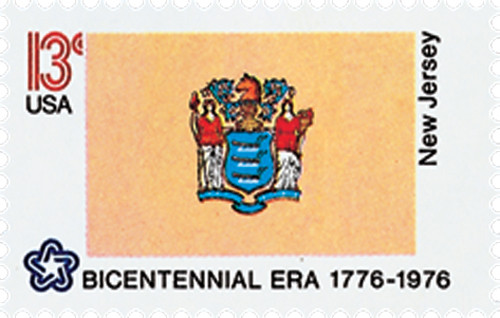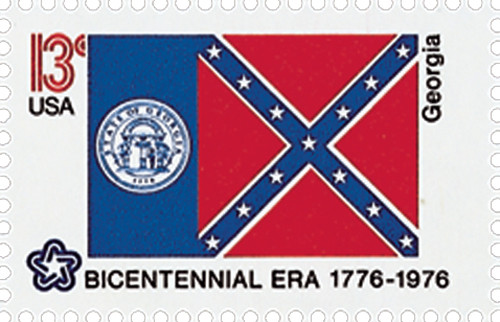
# 1681 - 1976 13c State Flags: Alaska
U.S. 1681
1976 Alaska
State Flags
American Bicentennial Series
• First time a sheet 50 had all different stamp designs
• Part of the American Bicentennial Series
Stamp Category: Commemorative
Series: American Bicentennial Series
Value: 13¢ First-class postage rate
First Day of Issue: February 23, 1976
First Day City(s): Washington, DC
Quantity Issued: 8,720,100 (panes of 50)
Printed by: Bureau of Engraving and Printing
Printing Method: Photogravure
Format: Sheet of 50
Perforations: 11
Why the stamp was issued:
The United States Postal Service celebrated the American Bicentennial with a full pane of the Union’s fifty state flags.
About the stamp design:
Alaska's current state flag was the winning entry in a contest sponsored by the American Legion in 1927, more than 30 years before the territory became a U.S. state. Designed by John Bell (Benny) Benson, a 13-year-old orphaned Aleut Indian, this flag was formally adopted in May 1927. The flag's blue background represented the sky and the Forget-me-not, Alaska's state flower. Against this background are eight gold stars to represent the Big Dipper, a symbol of strength, and the North Star, to represent Alaska's future as the northernmost U.S. state.
About the printing process:
Printed by the Bureau of Engraving and Printing on their seven-color Andreotti gravure press (601) which was their work horse for multicolored stamps.
About the American Bicentennial Series:
In the 1970s, America celebrated its 200th anniversary with hundreds of national events commemorating the heroes and historic events that led to our nation’s independence from Great Britain. The U.S. Postal Service issued 113 commemorative stamps over a six-year period in honor of the U.S. bicentennial, beginning with the American Revolution Bicentennial Commission Emblem stamp (U.S. #1432). As a group, the Bicentennial Series chronicles one of our nation’s most important chapters, and remembers the events and patriots who made the U.S. a world model for liberty.
Several of the stamps honored colonial life – craftsmen and communication. Other stamps honored important battles including Lexington and Concord, Bunker Hill, and Saratoga. Significant events such as the Boston Tea Party, the meeting of the First Continental Congress, and the Declaration of Independence were featured as well. The stamps also honored many significant people such as George Washington, Sybil Ludington, Salem Poor, and the Marquis de Lafayette.
Many of the stamps feature classic artwork. For instance, the set of four souvenir sheets picture important events recreated by noted artists such as John Trumbull. The Bicentennial Series also includes an important US postal first – the first 50-stamp se-tenant – featuring all 50 state flags. The format proved to be popular with collectors, and has been repeated many times since.
The American Bicentennial Series is packed with important US history – it tells the story of our nation’s fight for independence through stamps.
History the stamp represents:
Alaska was admitted to the Union on January 3, 1958 as the 49th state.
Most scientists believe the first people to live in America walked across a land bridge that connected Asia to Alaska more than 20,000 years ago. Then in 1648, Semen I. Dezhnev led a group of Russians across the narrow body of water that separates Asia from Alaska.
Over the years, fur brought Russian hunters and traders to Alaska. On the Aleutian Islands, and later on the mainland, a lucrative fur trade was developed. As a result, the populations of fur-bearing animals were decimated. The first white settlement in Alaska was established on Kodiak Island, in 1784. It was founded by Gregory Shelikof, who called it Russian America.
Russia attempted to build several industries in Alaska, including coal mining, ship building, and whaling. However, once the fur trade became less profitable, interest in the area declined. Russia’s economy was damaged by the costly Crimean War (1853-56). As a result, Russia decided to sell Alaska in 1867.
US Secretary of State William H. Seward agreed to buy Alaska for $7,200,000 – a cost of about 2¢ per acre. Today, with the perspective of history, Seward’s purchase is seen as a stroke of genius. At the time, many Americans opposed the purchase. In fact, some called it “Seward’s Folly”, and referred to Alaska as “Seward’s Icebox” and “Icebergia.” However, not all Americans opposed the purchase, and Congress approved the treaty.
Alaska had no independent government for the next 17 years. The territory was administered by the War Department, then the Treasury Department, and finally the Navy Department. No attention was given to local matters. Salmon first attracted U.S. companies to Alaska. The first cannery was built in 1878. Congress passed the First Organic Act for Alaska in 1884, establishing Alaska as a distinct “civil and judicial district.” Alaska was provided with a governor, a code of laws, and a federal court. However, Alaska’s laws were identical to Oregon’s, and did not fit Alaska’s conditions. Congress remained in control of lawmaking for Alaska.
Joseph Juneau and Richard T. Harris discovered gold in southeastern Alaska in 1880. Additional gold strikes led thousands to flock to Alaska to prospect and mine for gold. Between 1890 and 1900, Alaska’s population almost doubled, reaching 63,952 people.
Gold brought government attention to Alaska. A Board of Road Commissioners was created to build roads, trails, bridges, and ferries throughout the populated areas of the territory. In 1906, Alaskans were allowed to elect a representative to Congress. This representative could speak before the Congress, but could not vote. In 1912, the second Organic Act provided Alaska with a territorial legislature, with limited power.
Japanese attacks on Alaska during World War II changed perceptions about the territory, and movements for statehood were initiated. Several bills were introduced between the mid-1940s and the late 1950s. In 1958, Congress finally voted to admit Alaska into the Union and on January 3 Alaska achieved statehood. It was the first new US state since 1912.
U.S. 1681
1976 Alaska
State Flags
American Bicentennial Series
• First time a sheet 50 had all different stamp designs
• Part of the American Bicentennial Series
Stamp Category: Commemorative
Series: American Bicentennial Series
Value: 13¢ First-class postage rate
First Day of Issue: February 23, 1976
First Day City(s): Washington, DC
Quantity Issued: 8,720,100 (panes of 50)
Printed by: Bureau of Engraving and Printing
Printing Method: Photogravure
Format: Sheet of 50
Perforations: 11
Why the stamp was issued:
The United States Postal Service celebrated the American Bicentennial with a full pane of the Union’s fifty state flags.
About the stamp design:
Alaska's current state flag was the winning entry in a contest sponsored by the American Legion in 1927, more than 30 years before the territory became a U.S. state. Designed by John Bell (Benny) Benson, a 13-year-old orphaned Aleut Indian, this flag was formally adopted in May 1927. The flag's blue background represented the sky and the Forget-me-not, Alaska's state flower. Against this background are eight gold stars to represent the Big Dipper, a symbol of strength, and the North Star, to represent Alaska's future as the northernmost U.S. state.
About the printing process:
Printed by the Bureau of Engraving and Printing on their seven-color Andreotti gravure press (601) which was their work horse for multicolored stamps.
About the American Bicentennial Series:
In the 1970s, America celebrated its 200th anniversary with hundreds of national events commemorating the heroes and historic events that led to our nation’s independence from Great Britain. The U.S. Postal Service issued 113 commemorative stamps over a six-year period in honor of the U.S. bicentennial, beginning with the American Revolution Bicentennial Commission Emblem stamp (U.S. #1432). As a group, the Bicentennial Series chronicles one of our nation’s most important chapters, and remembers the events and patriots who made the U.S. a world model for liberty.
Several of the stamps honored colonial life – craftsmen and communication. Other stamps honored important battles including Lexington and Concord, Bunker Hill, and Saratoga. Significant events such as the Boston Tea Party, the meeting of the First Continental Congress, and the Declaration of Independence were featured as well. The stamps also honored many significant people such as George Washington, Sybil Ludington, Salem Poor, and the Marquis de Lafayette.
Many of the stamps feature classic artwork. For instance, the set of four souvenir sheets picture important events recreated by noted artists such as John Trumbull. The Bicentennial Series also includes an important US postal first – the first 50-stamp se-tenant – featuring all 50 state flags. The format proved to be popular with collectors, and has been repeated many times since.
The American Bicentennial Series is packed with important US history – it tells the story of our nation’s fight for independence through stamps.
History the stamp represents:
Alaska was admitted to the Union on January 3, 1958 as the 49th state.
Most scientists believe the first people to live in America walked across a land bridge that connected Asia to Alaska more than 20,000 years ago. Then in 1648, Semen I. Dezhnev led a group of Russians across the narrow body of water that separates Asia from Alaska.
Over the years, fur brought Russian hunters and traders to Alaska. On the Aleutian Islands, and later on the mainland, a lucrative fur trade was developed. As a result, the populations of fur-bearing animals were decimated. The first white settlement in Alaska was established on Kodiak Island, in 1784. It was founded by Gregory Shelikof, who called it Russian America.
Russia attempted to build several industries in Alaska, including coal mining, ship building, and whaling. However, once the fur trade became less profitable, interest in the area declined. Russia’s economy was damaged by the costly Crimean War (1853-56). As a result, Russia decided to sell Alaska in 1867.
US Secretary of State William H. Seward agreed to buy Alaska for $7,200,000 – a cost of about 2¢ per acre. Today, with the perspective of history, Seward’s purchase is seen as a stroke of genius. At the time, many Americans opposed the purchase. In fact, some called it “Seward’s Folly”, and referred to Alaska as “Seward’s Icebox” and “Icebergia.” However, not all Americans opposed the purchase, and Congress approved the treaty.
Alaska had no independent government for the next 17 years. The territory was administered by the War Department, then the Treasury Department, and finally the Navy Department. No attention was given to local matters. Salmon first attracted U.S. companies to Alaska. The first cannery was built in 1878. Congress passed the First Organic Act for Alaska in 1884, establishing Alaska as a distinct “civil and judicial district.” Alaska was provided with a governor, a code of laws, and a federal court. However, Alaska’s laws were identical to Oregon’s, and did not fit Alaska’s conditions. Congress remained in control of lawmaking for Alaska.
Joseph Juneau and Richard T. Harris discovered gold in southeastern Alaska in 1880. Additional gold strikes led thousands to flock to Alaska to prospect and mine for gold. Between 1890 and 1900, Alaska’s population almost doubled, reaching 63,952 people.
Gold brought government attention to Alaska. A Board of Road Commissioners was created to build roads, trails, bridges, and ferries throughout the populated areas of the territory. In 1906, Alaskans were allowed to elect a representative to Congress. This representative could speak before the Congress, but could not vote. In 1912, the second Organic Act provided Alaska with a territorial legislature, with limited power.
Japanese attacks on Alaska during World War II changed perceptions about the territory, and movements for statehood were initiated. Several bills were introduced between the mid-1940s and the late 1950s. In 1958, Congress finally voted to admit Alaska into the Union and on January 3 Alaska achieved statehood. It was the first new US state since 1912.


















